#1 day Inca trail hike
Text
Embarking on the Iconic Inca Trail Hike

Embarking on the Inca Trail Hike is an adventure of a lifetime, promising travelers an immersive journey through the breathtaking landscapes and ancient ruins of the Peruvian Andes. This legendary trek, known for its challenging terrain and historical significance, offers a profound experience that culminates at the awe-inspiring citadel of Machu Picchu.
The Inca Trail Hike typically spans four days and three nights, beginning at the trailhead in the Sacred Valley near the town of Ollantaytambo. From here, adventurers set out on a trek that leads through diverse ecosystems, from lush cloud forests to high-altitude mountain passes, each offering its own unique beauty and challenges.
Throughout the journey, hikers have the opportunity to explore ancient Inca ruins that dot the landscape, including the impressive archaeological sites of Llactapata, Runkurakay, Sayacmarca, and Phuyupatamarca. These remnants of the Inca civilization provide fascinating insights into their advanced engineering, architecture, and way of life.
One of the most memorable moments of the Inca Trail Hike is reaching the renowned Inti Punku, or Sun Gate, which offers a breathtaking panoramic view of Machu Picchu spread out below. This awe-inspiring sight marks the culmination of the trek, as hikers descend into the ancient citadel itself to explore its winding streets, towering temples, and enigmatic ruins.
Guided by experienced and knowledgeable professionals, travelers are supported every step of the way. Expert guides offer insights into the region's history, culture, and natural environment, enriching the experience with their expertise and passion for the land.
Camping under the stars each night adds to the sense of adventure, with delicious meals prepared by skilled chefs using locally-sourced ingredients ensuring that hikers are well-nourished and energized for each day's trek. Despite its challenges, completing the Inca Trail Hike is a deeply rewarding experience that leaves a lasting impression on all who undertake it. Whether you're a seasoned adventurer seeking a new challenge or a traveler eager to explore the wonders of the Andes, the Inca Trail Hike promises an unforgettable journey filled with adventure, discovery, and the timeless allure of Machu Picchu.
1 note
·
View note
Text
The Inca Trail - Parte Dos
Day 3 was only 6 miles but felt loooong as it incorporated over 3,000 steps downward. When we began, the clouds were laying between the mountains and rapidly moving. Just before lunch, we climbed up to the beautiful Inca site of Phuyupatamarca which aptly translates to "Village in the Clouds".

Again, we had a lovely 3 course lunch, adorned with animal food-based replicas. We took a brief tarp nap before continuing down. At one point, the rain began and we became poncho people. Luckily, the rain let up just in time for us to arrive at the Ruins of Intipata. Each Inca site we visited was increasingly more spectacular.
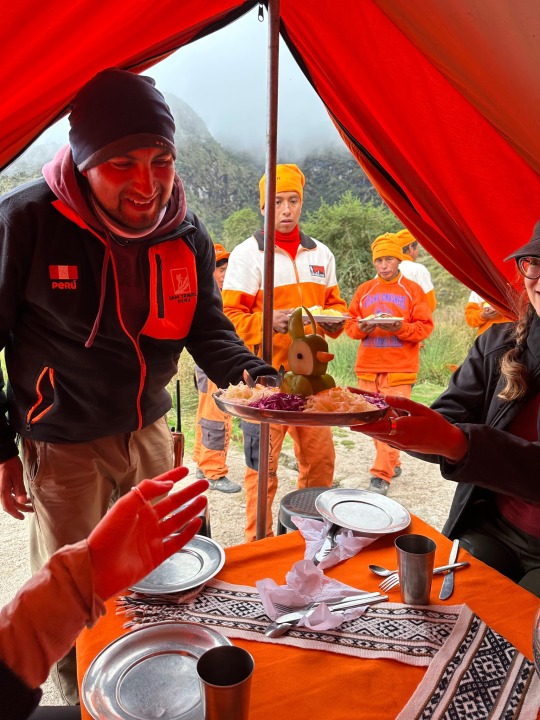
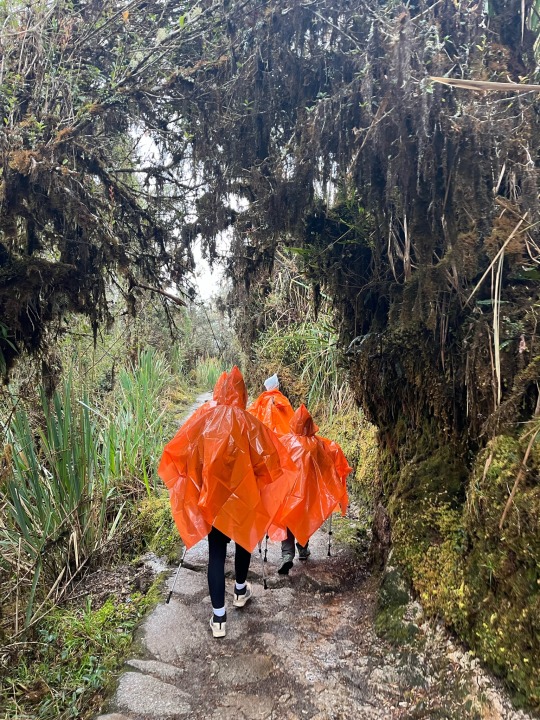

On our way from Intipata to our campsite we were greeted by a few trail llamas. At camp, the chef surprised us with a birthday cake he made on the trail for Vale! We had our last well-made camp dinner before the goodbye ceremony where we thanked and tipped our porters or "bebeees".
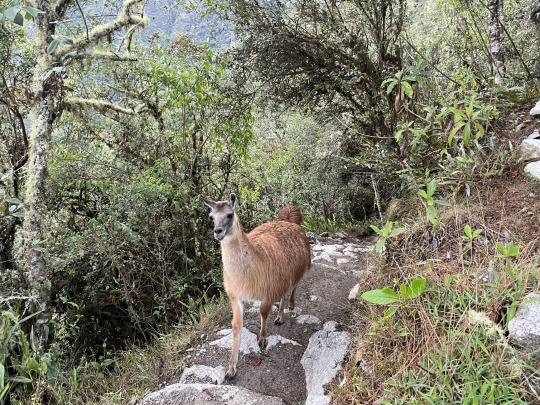
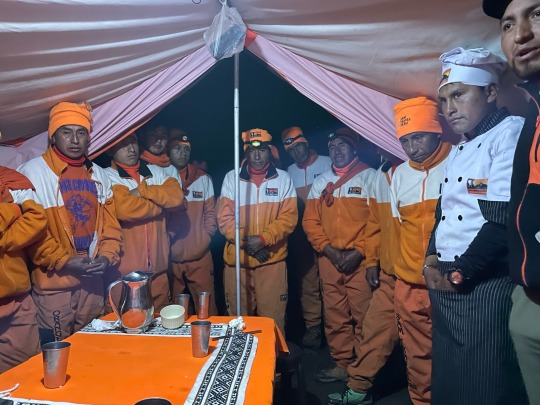
Before we knew it, the day we'd all been hiking for had arrived. We had a brutal 3 AM wakeup call so we could get to the checkpoint before the seats filled up. We actually got the last seats left and waited there until the trail opened at 5:30 AM. Luckily, we had some nice stars to observe as we waited.
We arrived at Inti Punku, or the Sun Gate, by 6:30 and caught our first glimpse of Machu Picchu!! Then, the photoshoots began. As we descended, we continued to get new and more spectacular views of the ruins.

After all the impressive Inca sites we saw along the trail, I expected Machu Picchu to be anti-climactic. It most certainly was not. The main questions that came to mind were how and why? Our guide talked us through a lot of the history but the truth is, most of it is quite a mystery. That makes the site even more special in my eyes.

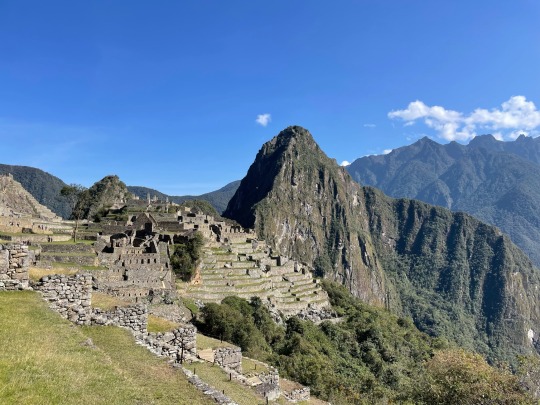
Bess, Josh, Junior, and I departed the group to begin our hike of Huayna Picchu Mountain which is on the list of the 20 most dangerous hikes in the world. With 1,000 ft of elevation gain in less than 1 mile, the hike was challenging but not impossible. It only took us about 45 minutes to reach the summit which had rewarding views of the Andes, Machu Picchu Mountain, and Machu Picchu itself.

On our way back, we walked through Machu Picchu again and were almost trampled by two crazy llamas! We thought, wouldn't it have been crazy to survive one of the worlds most dangerous hikes just to have been killed by llamas when we finished?
We ended the trip with a relaxing lunch in the scenic town of Aguas Calientes before venturing back to Cusco.
4 notes
·
View notes
Text
Places to Go for Vacation
Introduction
Planning a vacation is an exciting endeavor, and the world is brimming with remarkable destinations to explore. Whether you're seeking natural beauty, cultural richness, adventure, or relaxation, there's a perfect vacation spot for everyone. In this article, we'll take a tour of some of the top places to go for vacation, each offering a unique and unforgettable experience.
1. Bali, Indonesia
Known as the "Island of the Gods," Bali is a tropical paradise with stunning beaches, lush rainforests, and vibrant culture. Visitors can explore ancient temples, enjoy water sports, and savor Balinese cuisine. Don't miss the tranquil rice terraces and the energetic nightlife in Seminyak.
2. Santorini, Greece
Santorini, an enchanting island in the Aegean Sea, is famous for its iconic white-washed buildings, crystal-clear waters, and dramatic sunsets. It's a romantic destination with breathtaking views, ancient ruins, and delicious Mediterranean cuisine.
3. Kyoto, Japan
For a taste of Japanese culture and history, Kyoto is a must-visit. This city is renowned for its traditional tea houses, stunning cherry blossoms in spring, and beautiful temples. Stroll through bamboo forests, participate in tea ceremonies, and admire the art of the geisha.
4. Bora Bora, French Polynesia
Bora Bora is synonymous with paradise. Its turquoise lagoons, overwater bungalows, and coral reefs make it a dream destination for honeymooners and water enthusiasts. Snorkeling, scuba diving, and relaxation are the order of the day.
5. Tuscany, Italy
Tuscany's rolling hills, historic cities, and delectable cuisine make it a favorite European destination. Explore the charming streets of Florence, sample world-class wines in Chianti, and savor the simple pleasures of life in the Tuscan countryside.
6. Maldives
The Maldives, a collection of over a thousand coral islands, is a tropical haven with luxury resorts and stunning marine life. It's an ideal spot for beach lovers, honeymooners, and those seeking seclusion in paradise.
7. Machu Picchu, Peru
Machu Picchu, the ancient Inca citadel nestled in the Andes Mountains, is a UNESCO World Heritage site and one of the world's most iconic travel destinations. Hike the Inca Trail or take the train to witness this archaeological wonder.
8. New York City, USA
For the bustling urban experience, New York City is a top choice. Explore iconic landmarks like Times Square, Central Park, and the Statue of Liberty. The city offers a vibrant arts scene, diverse cuisine, and endless entertainment.
9. Cape Town, South Africa
Cape Town is a city of breathtaking beauty, nestled between Table Mountain and the Atlantic Ocean. Explore vibrant neighborhoods, visit the Cape of Good Hope, and savor South African wines in the surrounding vineyards.
10. Patagonia, Argentina and Chile
Patagonia offers awe-inspiring natural beauty with its glaciers, mountains, and remote wilderness. It's a dream destination for hikers, nature lovers, and wildlife enthusiasts.
11. Iceland
Iceland's dramatic landscapes include geysers, waterfalls, volcanoes, and geothermal springs. The Blue Lagoon, the Golden Circle, and the Northern Lights are just a few of the attractions that make Iceland a unique vacation destination.
12. Marrakech, Morocco
Marrakech is a bustling and exotic city in North Africa. Explore the bustling souks, visit the historic medina, and relax in stunning riads. Marrakech offers a blend of tradition and modernity.
13. Sydney, Australia
Sydney, with its iconic Opera House and Sydney Harbour Bridge, is a vibrant city with beautiful beaches, world-class dining, and a variety of cultural attractions. The city's coastal charm and natural beauty are hard to resist.
14. Rio de Janeiro, Brazil
Rio de Janeiro is known for its lively Carnival, stunning beaches, and iconic Christ the Redeemer statue. Enjoy samba music, relax on Copacabana Beach, and explore the lush Tijuca Forest.
15. Istanbul, Turkey
Istanbul straddles Europe and Asia, offering a rich blend of cultures, history, and architecture. Visit the Hagia Sophia, the Blue Mosque, and the Grand Bazaar for an unforgettable experience.
Conclusion
The world is a treasure trove of vacation destinations, each offering a unique blend of natural beauty, culture, history, and adventure. Whether you're drawn to tropical paradises, ancient cities, or remote wilderness, there's a place for every traveler to discover and savor. When planning your next vacation, consider the experiences that ignite your wanderlust and create memories that will last a lifetime.
2 notes
·
View notes
Video
TREKS IN CUSCO por cusco destination
Por Flickr:
CHOQUEQUIRAO TREK You can visit the architectural complex Choquequirao is situated in Vilcabamba at 3100 meters, considered the last Inka refuge and place of resistance from the invaders, when doing this trek you will enjoy beautiful scenery, you'll see the impressive Apurimac Canyon, flora and wildlife along the path. This route offers a strenuous but formidable journey due to the various existing ecosystems. Useful Information - Starting Altitude - 2900m / 9515ft. - Highest Altitude - 3050m / 10,005ft- Walking Distance - 64 km / 40 miles- Longest Day - Day 1, approximately 25 km/15.5 miles- Overall Difficulty - Difficult INCA JUNGLE TO MACHU PICCHU Our Inca Jungle Trail classic To Machu Picchu combines adventure sports such as mountain biking, rafting, zip line, hot spring and trekking for 4 days until you reach Machu Picchu and one of the additional mountains "Machu Picchu Mountain" or "Huaynapicchu". The Inca Jungle route is the favorite tour for young people from all over the world who come to Cusco in search of deferent adventures and extreme sports. As a Tourism Agency located in Cusco we offer a differentiated service; with an exclusive route, trained guides (real command of English, local history and adventure sports), bicycles equipped for downhill, the safest rafting and zipline services. We recommend our passengers book in advance to have everything insured and avoid unnecessary risks such as loss of equipment, lack of access to Machu Picchu, Machu Picchu Mountain, Huayna Picchu or even worse, being stranded in Aguas Calientes (no return train). This tour is one of the classic routes full of adrenaline to the Inca citadel of Machu Picchu.Useful Information - Starting Altitude: 4400m / 14435ft. - Highest Altitude: 4350 meters / 14271 ft. - Minimum Altitude: 1430 meters / 4691 ft - Biking distance: 65km / 40 mile - Biking time: 3.5 to 4 hour approximately. - Hiking distance: 19 Kilometers / 12.3 mile - Overall Difficulty: Moderate INCA QAURRY TREK TO MACHU PICCHU The quarry of Cachicata was the place of extraction of the stones that were used for the construction of Ollantaytambo and many surrounding areas. This place is 9 kilometers from the Inca town of Ollantaytambo and has three groups of quarries: Molle Pucro, Sirkusirkuyoc (it was the largest), shows evidence of having been in full operation when the Spaniards entered this area. And finally Kantirayoq or Cacchicata, where another type of extraction of minerals and precious stones was practiced.Useful Information - Starting Altitude - 3350 meters / 10990 feet . - Highest Altitude - 4500m / 14,764ft- Walking Distance - 25 km / 15.5 miles- Meals - 2 breakfast, 2 lunch, 2 dinner, 2 tea times, 2 wake up tea- Overall Difficulty - Moderate- STARTING POINT: - Cusco at your hotel
2 notes
·
View notes
Text
Wow! We have done so much since my last post.
We left Cusco a few days ago on our way to Machu Picchu. We took the easy option by train and bus, whilst the others on our tour spent 3 days hiking on the Inca and Quarry trail ( it's an age thing ) Anyway more of that later.
We left Cusco for a detour and overnight stay to the sacred valley. Only 4 of us,but well worth the trip. We sampled the Peruvian corn beer, but don't get excited it is only 1.5% Vol ( I think top deck shandy has more alcohol than that ). At the bar we also found the Guinea pig store, all still alive. you just ,have to do is choose one, and they do the rest. Don't worry we didn't do it. However we did drive through, The Guinea Pig mile, where every restaurant sells Guinea Pig. We stopped at one, but just to confirm, before I cause any more offence, it was just for a photo opportunity.
Next day we travelled to ollantaytambo, for another overnighter, a really nice little place, where I had 1, 2 too many proper peruvian beers. The following day we ran up a load of ancient Inca steps, just for fun and a few more photos opportunities, before boarding the Inca Rail to Machu Picchu. I think it must have been 1st class, as we had traditional singers and dancers to see us onto the train,and then a performance of a traditional folk song, it was like a show at disney world. ( I will post the video later, for those who aren't bored enough already ) We stayed overnight in Machu Picchu town, full of backpackers, restaurants and gift shops along with the obligatory, hundreds of requests to either eat in restaurants or buy souvenirs. At least they understand 'No thanks'.
Early start next day on the bus to Machu Picchu itself. Thankfully the weather held for us and we were able to take classic pictures of the ruins, but with us in them.Absolutely amazing, just gob smacked to be there, and Ann had the obligatory emotional moment, before we took literally hundreds of photos. luckily the battery in my camera and phone lasted. I promise not to post them all.
Today we booked a trip to Rainbow Mountain with 4 others from the tour. I think they were a but worried we might not make it to the top, as its a steep walk of 1.5 hours from the car park to reach the 5000m summit ( Apparently the same height as Everest base camp, however our next trip will not be to Nepal ) We prepared with altitude sickness medication and resisted the opportunity to hire horses up to the top, more in pity that one of the unlucky nags would have to carry me. Great achievement and great photos.
Back at the hotel in Cusco now recovering from our ordeal. I think we may have a sleep before dinner.
Off to the peruvian amazon tomorrow in search of the legendary Yakumama.
Next post after our amazon adventure.
5 notes
·
View notes
Text
Exploring the Lares Trek Distance: A Journey Through Peru's Hidden Gem

When it comes to trekking in Peru, the Inca Trail often steals the spotlight. However, for those seeking a more off-the-beaten-path adventure, the Lares Trek is an exceptional alternative. This trek not only offers stunning landscapes and rich cultural experiences but also allows for a more intimate encounter with the Andean way of life. In this blog, we'll explore the Lares Trek distance and why it should be on your travel bucket list.
Understanding the Lares Trek Distance
The Lares Trek distance varies depending on the specific route chosen, but it typically spans around 33 to 40 kilometers (20 to 25 miles). This distance is spread over three to four days, making it a manageable yet rewarding challenge for trekkers of varying fitness levels. The trek begins in the Sacred Valley and winds its way through picturesque villages, lush valleys, and high mountain passes, eventually concluding at the iconic Machu Picchu.
Day-by-Day Breakdown of the Lares Trek Distance
Day 1: Cusco to Lares Hot Springs The journey begins with a scenic drive from Cusco to the village of Lares. Here, trekkers can relax and acclimate to the altitude by soaking in the natural hot springs. The trekking starts with a gentle hike to the first campsite, covering approximately 6 kilometers (3.7 miles). This introductory leg of the trek offers a taste of the beautiful landscapes and prepares you for the days ahead.
Day 2: Lares Hot Springs to Huacahuasi The second day is one of the most challenging but also the most rewarding. Trekkers will cover around 16 kilometers (10 miles), ascending to the Ipsaycocha Pass at 4,450 meters (14,600 feet). The climb is steep, but the panoramic views of the Andean peaks and the chance to visit remote indigenous communities make it all worthwhile.
Day 3: Huacahuasi to Patacancha On this day, the trail descends into the valley, leading to the village of Patacancha. The distance covered is about 10 kilometers (6.2 miles). Along the way, you'll pass through traditional villages where locals still practice ancient weaving techniques and agricultural methods. This cultural immersion is a highlight of the Lares Trek distance.
Day 4: Patacancha to Ollantaytambo and Train to Machu Picchu The final trekking day is shorter, covering around 7 kilometers (4.3 miles) to the town of Ollantaytambo. From here, a scenic train ride takes you to Aguas Calientes, the gateway to Machu Picchu. The excitement builds as you prepare to explore one of the New Seven Wonders of the World.
Why Choose the Lares Trek?
The Lares Trek distance may be shorter than some other trekking routes, but what it lacks in length, it makes up for in cultural richness and natural beauty. This trek offers a more secluded and serene experience compared to the busier Inca Trail. You'll encounter fewer tourists and have more opportunities to interact with local communities, gaining insights into their traditional way of life.
Moreover, the diverse landscapes, from high-altitude passes to verdant valleys, provide a constantly changing and visually stunning backdrop to your journey. The Lares Trek also allows for a more flexible itinerary, with options to customize the route based on your preferences and fitness level.
Alpaca Expeditions: Your Trusted Guide
For those interested in embarking on the Lares Trek, Alpaca Expeditions is a top choice. They offer expertly guided tours that ensure you experience the trek safely and comfortably. Their knowledgeable guides provide valuable insights into the local culture and history, enhancing your overall experience.
Alpaca Expeditions also prioritizes sustainable and responsible tourism. They work closely with local communities, ensuring that your visit has a positive impact on the region. With their well-organized logistics and attention to detail, you can focus on enjoying the journey without any worries.
In conclusion, the Lares Trek distance may be just a number, but the experiences and memories you'll gain along the way are immeasurable. This trek is a perfect blend of adventure, culture, and natural beauty, offering a unique perspective on the Peruvian Andes. Whether you're an experienced hiker or a first-time trekker, the Lares Trek is an unforgettable journey that should not be missed.
0 notes
Text
Explore Machu Picchu and the Amazon in 10 Days with Amazing Andean Adventures
Embark on an unforgettable journey that combines two of South America's most iconic natural wonders: Machu Picchu and the Amazon Rainforest. Amazing Andean Adventures offers a thrilling 10-day, 9-night adventure that will leave you in awe of the beauty and diversity of Peru. This tour promises a unique blend of history, culture, and nature, making it the perfect escape for those seeking an extraordinary travel experience.

Day 1-4: Discover the Wonders of Machu Picchu
Your journey begins with a visit to the magnificent Inca citadel of Machu Picchu. One of the New Seven Wonders of the World, Machu Picchu is a UNESCO World Heritage site that attracts travelers from around the globe. You'll explore the ancient ruins, hike through the misty cloud forest, and witness breathtaking views of the Andes Mountains.
Led by experienced guides, you will learn about the fascinating history of the Inca Empire and the significance of this archaeological treasure. Whether you choose to trek the Inca Trail or take the scenic train to the site, Amazing Andean Adventures ensures a seamless and enriching experience.
Day 5-10: Immerse Yourself in the Amazon Rainforest
After immersing yourself in the history of the Incas, your adventure continues in the lush and vibrant Amazon Rainforest. This leg of the journey offers an entirely different experience as you navigate through the world’s largest tropical rainforest.
With expert naturalists by your side, you'll explore the depths of the Amazon, spotting exotic wildlife like monkeys, colorful birds, and even elusive jaguars. Take guided hikes, canoe trips, and nighttime safaris to uncover the mysteries of this biodiverse paradise. You’ll stay in eco-lodges, waking up to the sounds of nature and enjoying traditional Amazonian cuisine.

Why Choose Amazing Andean Adventures?
Amazing Andean Adventures prides itself on providing personalized, high-quality tours that cater to both adventure seekers and cultural enthusiasts. With a focus on sustainable tourism, the company ensures that you not only experience the wonders of Peru but also contribute to the preservation of its natural beauty.
This 10-day Machu Picchu and the Amazon trip is designed for travelers who crave a combination of adventure, culture, and nature. Whether you’re an experienced traveler or someone looking for a once-in-a-lifetime experience, Amazing Andean Adventures will guide you every step of the way.
Book Your Adventure Today!
Don’t miss out on this incredible opportunity to see two of Peru’s most famous destinations in one trip. Book your 10-day Machu Picchu and Amazon adventure with Amazing Andean Adventures and make memories that will last a lifetime!
0 notes
Text
Hike the Salkantay Trail: A Must-Do for Machu Picchu Visitors
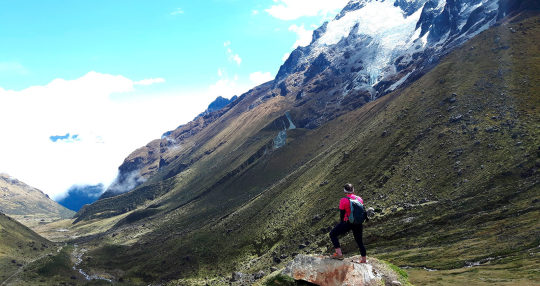
When planning a visit to the world-renowned Machu Picchu, most travelers immediately think of the famous Inca Trail. However, for those seeking a more adventurous and off-the-beaten-path experience, the Salkantay Trek to Machu Picchu is an exceptional alternative. This trail offers breathtaking scenery, diverse ecosystems, and a chance to connect with the Andean culture in a way that few other routes can match.
What Makes the Salkantay Trek Special?
The Salkantay Trek to Machu Picchu is often referred to as the "alternative Inca Trail," but it's much more than just an alternative. Named after the towering Salkantay Mountain (6,271 meters), this trek is a high-altitude adventure that takes hikers through some of the most stunning landscapes in Peru. From snow-capped peaks to lush cloud forests, the trail offers a variety of ecosystems that change dramatically as you descend towards Machu Picchu.
Unlike the Inca Trail, the Salkantay Trek is less crowded, providing a more serene and intimate hiking experience. This is ideal for those who want to immerse themselves in nature and enjoy the solitude that comes with trekking through remote Andean paths.
The Journey: What to Expect
The Salkantay Trek typically spans five days and covers approximately 74 kilometers (46 miles). The journey begins in the small village of Mollepata and takes hikers through a variety of terrains, each offering its own unique challenges and rewards.
Day 1: The trek starts with a gradual ascent, allowing hikers to acclimatize to the altitude. The trail winds through rolling hills and verdant valleys, with the majestic Salkantay Mountain looming in the distance.
Day 2: This is the most challenging day, as hikers reach the highest point of the trek, the Salkantay Pass at 4,650 meters (15,255 feet). The views from the pass are nothing short of spectacular, with panoramic vistas of snow-capped peaks and rugged landscapes.
Day 3: After the strenuous climb, the trail descends into the lush cloud forest, where hikers are greeted by a dramatic change in scenery. The warm, humid air and vibrant flora make for a refreshing contrast to the barren highlands.
Day 4: The trek continues through the cloud forest, passing through small villages and coffee plantations. This is a day to soak in the rich biodiversity of the region, with opportunities to spot exotic birds and unique plant species.
Day 5: The final stretch takes hikers along the banks of the Urubamba River to the town of Aguas Calientes, the gateway to Machu Picchu. From here, it's a short bus ride to the entrance of the iconic Inca citadel, where the adventure culminates in a visit to one of the New Seven Wonders of the World.
Why Choose the Salkantay Trek?
The Salkantay Trek to Machu Picchu is perfect for those looking for a more rugged and less commercialized route to Machu Picchu. It's a trek that challenges the body and mind, rewarding hikers with a profound sense of accomplishment and memories that will last a lifetime.
Additionally, the Salkantay Trek offers flexibility. Unlike the Inca Trail, which requires permits that sell out months in advance, the Salkantay Trek does not have such restrictions. This makes it a more accessible option for last-minute travelers or those who prefer a more spontaneous adventure.
Combining the Salkantay Trek with Machu Picchu Tours
For visitors who want to make the most of their journey, combining the Salkantay Trek with one of the many available Machu Picchu tours is an excellent choice. These tours often include guided visits to the citadel, providing insightful commentary on the history and significance of the site. Some tours also offer the option to visit other nearby attractions, such as the Sacred Valley or the lesser-known Inca ruins of Choquequirao.
Whether you're a seasoned trekker or a first-time visitor to Peru, the Salkantay Trek to Machu Picchu offers an unforgettable adventure. It’s a journey that takes you through some of the most awe-inspiring landscapes in the Andes, ending at one of the most iconic archaeological sites in the world. If you're planning a trip to Machu Picchu, don't miss the opportunity to experience the magic of the Salkantay Trail.
0 notes
Text
The Ultimate Guide to the Inca Trail 4 Days: An Unforgettable Adventure with QoricanchaExpeditions
Embarking on the Inca Trail is a dream for many adventurers and history enthusiasts alike. The allure of walking the same paths once tread by the ancient Incas, surrounded by breathtaking landscapes and historical wonders, makes it a once-in-a-lifetime experience. At QoricanchaExpeditions, we offer a meticulously planned 4-day Inca Trail trek that ensures you get the most out of this legendary journey.

Day 1: Starting the Adventure
Cusco to Wayllabamba
Your journey begins in the vibrant city of Cusco, where you'll meet your guide and fellow trekkers. From Cusco, we'll drive to the trailhead at Piscacucho (Km 82). The first day is a relatively easy hike, allowing you to acclimate to the altitude and get a taste of the stunning scenery to come. We'll pass through small Andean villages and archaeological sites like Patallacta, giving you a glimpse into the rich history and culture of the region. Our first campsite is at Wayllabamba, where you can rest and prepare for the challenging days ahead.
Day 2: The Challenge of Dead Woman's Pass
Wayllabamba to Pacaymayo
Day two is often considered the most challenging, as we ascend to the highest point of the trail, known as Dead Woman's Pass (Warmiwañusca). The climb is steep and demanding, but the reward is an unparalleled view of the Andes mountains. After reaching the pass, we'll descend into the Pacaymayo Valley, where we'll set up camp for the night. The sense of accomplishment from conquering the pass will fuel your spirits as you relax and enjoy the tranquility of the valley.
Day 3: Exploring Incan Ruins
Pacaymayo to Wiñay Wayna
The third day takes us through a series of impressive Incan ruins and lush cloud forests. We'll visit Runkuraqay, Sayacmarca, and Phuyupatamarca, each offering a unique glimpse into the architectural prowess and spiritual significance of the Incan civilization. As we descend further, the landscape changes dramatically, becoming more verdant and humid. Our campsite at Wiñay Wayna is close to the famous Inti Punku (Sun Gate), providing a perfect vantage point for our final day's destination.
Day 4: Sunrise at Machu Picchu
Wiñay Wayna to Machu Picchu
On the last day of our trek, we'll rise early to reach Inti Punku in time for sunrise. The sight of Machu Picchu bathed in the golden morning light is a moment you'll cherish forever. As you walk through the Sun Gate, the ancient citadel unfolds before you in all its glory. We'll spend the day exploring Machu Picchu with a knowledgeable guide who will bring the history and mystery of this UNESCO World Heritage site to life. Afterward, we'll take a bus down to Aguas Calientes for a well-deserved rest and celebration.
Why Choose QoricanchaExpeditions?

At QoricanchaExpeditions, we pride ourselves on providing a comprehensive and enriching Inca Trail experience. Our expert guides, well-planned itineraries, and commitment to sustainability ensure that your trek is safe, enjoyable, and respectful of the environment and local communities. We handle all logistics, so you can focus on the adventure and soak in the beauty and history of the Inca Trail.
Tips for a Successful Trek
Acclimatize Properly: Spend a few days in Cusco before your trek to acclimate to the altitude.
Pack Smart: Bring essentials like a good pair of hiking boots, layered clothing, and a reliable backpack.
Stay Hydrated: Drink plenty of water to stay hydrated, especially at higher altitudes.
Respect the Trail: Follow Leave No Trace principles to preserve the trail for future generations.
Join QoricanchaExpeditions for an unforgettable journey along the Inca Trail. Contact us today to book your adventure and walk in the footsteps of the Incas.
0 notes
Text
Cusco Tips and Art History
A trip to Cusco is so chaotic. You must fly in (or bus 20 hours) from Lima, landing in Cusco. But from Cusco you have to take a 4-5 hour drive to the town of Ollantaytambo. Ollantaytambo has some beautiful Inca ruins - some you can pay for, and some you can freely wander and hike around. In fact, the houses and restaurants in this small town are built upon ancient inca ruins. You can see where the Inca rocks end and the more modern Peruvian walls begin. They also still use the canal and aqueduct system that the inca built. If you do the Inca Trail hike to Machu Picchu, this is where you’d begin. It was a lovely place to spend the night, because afterwards, you need to take a 2 hour $80 train ride to “Machu Picchu Town” also known as Aguascalientes. Aguascalientes is the squished, pricy, seedy, tourist town of your nightmares! It’s just the basecamp for Machu Picchu. From here - you are finally just a thirty minute bus ride away from Machu Picchu! Trust me, the travel is exhausting.

Ollantaytambo Încă ruins
With my parents we took advantage to do the Wayna Picchu (big mountain) hike. First you enter the citadel doing a tour of 1 of the 4 routes. Then you sign off your name and your life in a tracking notebook, and begin your hike in the highland jungle. This was a hike with many downhills and uphills, areas where you had to grab onto ropes or poles to keep your balance. We weren’t sure if we’d make it all the way up, but in the end we did! 10 minutes after sitting nearly at the top, a park ranger came by guiding the last people off the mountain. We quickly scrambled up the last 10 minutes to take more pictures. Then the park ranger followed us all the way down the mountain. This gave me anxiety but we were proud to be the last ones on Wayna Picchu that day.
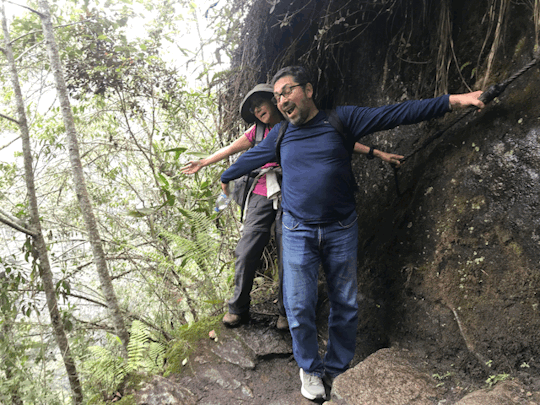
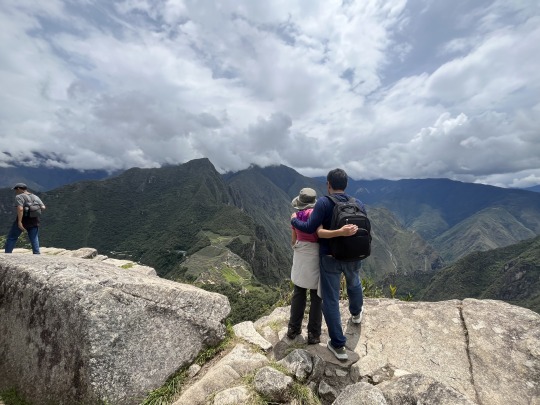
From this view, Machu Picchu is supposed to appear to be the shape of a condor.

We made it down!
Of course, we weren’t going to leave town without doing the most famous Machu Picchu route, and getting our llama picture. So the next day we did the Llaqta Machu Picchu route in the citadel. It started to rain, and when we got to the best picture point, the clouds covered the entire view of the citadel. Alas, a benevolent wind brushed away the clouds and we were able to get some rainy pictures in our pink and green ponchos. The guide told us about how carbon-dating the rocks showed the Incas ate a diet of corn, chicha, potatoes, yams, avocado, beans, coca leaves and other fruits, grains, vegetables, and nuts. The Incas maintained an essentially vegan diet, punctualized by a fried guinea pig or duck meat on special occasions. Machu Picchu has extensive planting terraces complete with irrigation and drainage systems. Now llamas, wild chinchillas, and spectacled bears enjoy the landscape. There are also Andean pumas, condors, and snakes, known as the Inca Trilogy. It was said that the snake guarded the underworld, the condor the spirit world, and the puma the earthly world. Machu Picchu was beautiful, and it was worth all the hassle! But they really make you work for it.
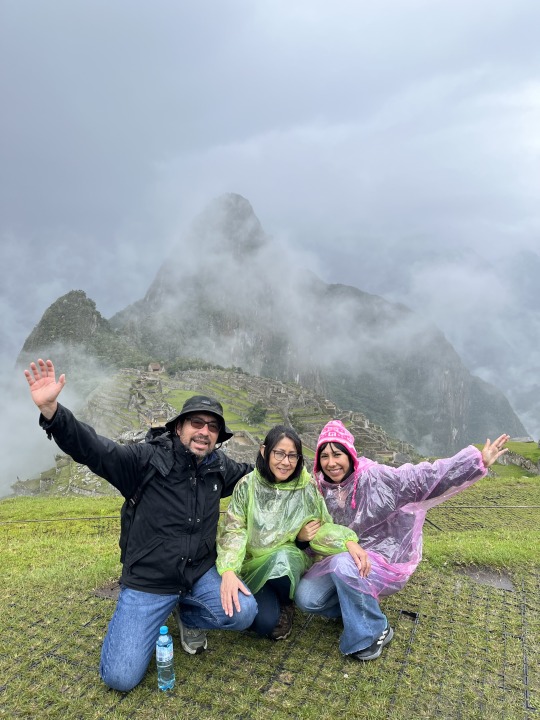
After that we went back to the city of Cusco. We toured a Catholic convent that was built on top of Inca ruins with no second thoughts. Today it is just a tourist attraction. We observed some lively Cusqueño dances. I tried to convince my parents to go see more ruins, but they were all ruined-out, and even museumed-out! I never thought I’d see the day I’d be forcing my parents to go to a museum. Even more remarkably, I had to convince them to go to mass. The Cusco Cathedral charges like 50 soles per person to tour it, but if you go to 7,8, or 10 am mass, you can enter for free. My dad takes after my sleeping-in tendencies, so 10 am is early for us. I rushed my parents through their breakfast (there were some delicious olives and we ate like 40).
The Cathedral was large and beautiful, with a huge old wooden organ in the center, and dozens of paintings from the famous Cusco School of Art. This art school was a movement of guilds, artists, and workshops, in which Spaniards and other European artists trained indigenous artists in order to help Peruvians convert to Catholicism. The art school/movement started from the Spanish conquest in the 1530s and lasted through the 1800s. Many of these trained artists maintained their Inca heritage, so they took these European painting styles and religious subjects and changed them to better fit their beliefs. They painted God and the saints in a triangular form with rivers running around their ankles and golden crowns with rays of sun on their heads. This is because the Incas worshipped mountains, rivers, and the sun, believing these to be their gods. The triangle shape of the Catholic subjects suggested a mountain, and embedded gold paint or gold threads were a representation of the sun. (Even priestcloths were often woven with gold or silver threads). We saw many of these features within the Cathedral, including the very famous Peruvian last supper painting, which includes Peruvian foods like stuffed red spicy peppers, corn, chicha, and a special main course. While one man tried to flush us out of the Cathedral after mass, another man very graciously pointed us to the Peruvian Last Supper, painted by Marcos Zapata in 1753- a highlight of my trip.

Do you see the special main dish? it’s a guinea pig
Tragically, most of the indigenous painters in the School of Art were forbidden from signing their own paintings, and most of the art from this period is unidentifiable. And like many other buildings in Cusco, the Cathedral was built directly on top of an Inca buildings - a palace known as Kiswarkancha.

Since we were tired of everything, we wined and dined around Cusco, and enjoyed the ever-changing weather. Sunny, warm, rainy, windy, cold. Cusco also has some of the best deals for souvenirs - do your shopping nearby the famous 12-angled stone for the best prices.
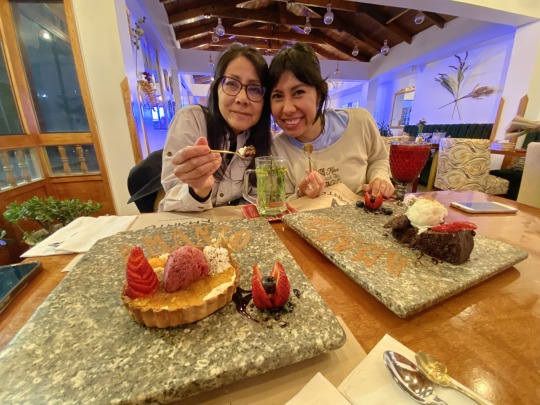
0 notes
Text
A 4-Day Journey Along the Lares Trek to Machu Picchu
In the heart of the Peruvian Andes lies an adventure waiting to be uncovered — the awe-inspiring Lares Trek to Machu Picchu 4 days. Our journey transcends the ordinary, offering a 4-day expedition that encapsulates the rich cultural tapestry, breathtaking landscapes, and the ancient allure of the Inca civilization.

Exploring the Andean Wonderland
The Lares Trek is a hidden gem, often overshadowed by the more popular Inca Trail. Yet, its allure lies in its exclusivity, providing a more intimate connection with the Andean landscape and local communities. Our Machu Picchu 4 day Hike journey delves into the heart of this unique trek, promising a blend of adventure and cultural immersion.
Traversing the Lares Trail: A 4-Day Itinerary
1. Cusco to Quishuarani
Our expedition kicks off in the historic city of Cusco, where we embark on a scenic drive to Quishuarani. Nestled amidst picturesque mountains, this quaint village sets the stage for our trek. Along the way, we encounter local communities, gaining insights into their customs and traditions.
2. Quishuarani to Cancha Cancha
The trail unfolds as we trek to Cancha Cancha, weaving through undulating landscapes and verdant valleys. This leg of the journey is punctuated by encounters with indigenous Quechua-speaking communities, providing a firsthand experience of Andean life.
3. Cancha Cancha to Ollantaytambo
As we ascend higher, the landscape transforms, offering panoramic views of majestic peaks. Our trek leads us to the archaeological wonder of Ollantaytambo, where ancient ruins whisper tales of the Inca civilization.
4. Ollantaytambo to Machu Picchu
The pinnacle of our journey is reached as we venture to Machu Picchu. Opting for the less-traveled path, we unveil the iconic citadel, savoring the moment without the crowds. Our 4-day odyssey concludes with the breathtaking sunrise over Machu Picchu, an unparalleled reward for our trekking endeavors.
Contact us for:-
Inca Trail private tour
Shortest hike to Machu Picchu
Salkantay Trek to Machu Picchu
Capturing Andean Wonders
To enhance the reader's experience, consider incorporating stunning visuals such as photos capturing the diverse landscapes, the vibrant local culture, and the awe-inspiring moments along the trek. Visual elements engage the audience and evoke a sense of wanderlust.
Conclusion
Our 4-day journey along the Lares Trek to Machu Picchu is more than a trek; it's an odyssey of cultural immersion, natural marvels, and historical revelations. As we traverse through the Andean wonders, we invite fellow adventurers to join us in unlocking the secrets of this hidden gem.
1 note
·
View note
Text
Experience 1 Day Inca Trail Hike to Machu Picchu
Experience the wonder of Machu Picchu in just one day with our Inca Trail hike. This thrilling trek offers a condensed but unforgettable journey to the iconic archaeological site.
0 notes
Text
2-Day Short Inca Trail Hike to Machu Picchu
The Inca Trail is renowned worldwide for its breathtaking beauty and historical significance. While the traditional 4-day Inca Trail hike is the most popular option, not everyone has the luxury of time. For those with limited time but a burning desire to experience the magic of the Inca Trail and witness the awe-inspiring Machu Picchu, the 2-Day Short Inca Trail Hike to Machu Picchu is the perfect solution. In this blog post, we will delve into the details of this incredible adventure, highlighting the key features and benefits of embarking on a 2-day journey to Machu Picchu.

1. The Essence of the Inca Trail in a Shorter Timeframe
The 2 Day Inca Trail Hike offers a condensed version of the classic Inca Trail experience, allowing adventurers to soak in the essence of this ancient trail in just two days. While the traditional 4-day hike covers approximately 45 kilometers, the 2-day option focuses on the most scenic and iconic sections, ensuring you don't miss out on the awe-inspiring views and historical sites.
2. Spectacular Scenery and Natural Wonders
Despite its shorter duration, the 2-Day Short Inca Trail Hike still provides an abundance of breathtaking natural beauty. Along the trail, hikers will encounter lush cloud forests, majestic mountains, and panoramic vistas that will leave them in awe. The trail takes you through diverse ecosystems, including stunning flora and fauna, making it a truly memorable journey.
3. Intimate Connection with Inca History
The Inca Trail is steeped in history, and the 2-Day Short Inca Trail Hike offers glimpses into the fascinating world of the ancient Incas. Along the way, hikers will encounter impressive archaeological sites, including Wiñay Wayna, an intricate Inca ruin, and Inti Punku, also known as the Sun Gate, where you will catch your first breathtaking glimpse of Machu Picchu.
4. Awe-Inspiring Arrival at Machu Picchu
The highlight of the 2-Day Short Inca Trail Hike is undoubtedly the arrival at Machu Picchu. On the second day of the trek, hikers make their way to the Sun Gate, where they are rewarded with a mesmerizing view of the iconic ancient citadel. As you descend into the sanctuary, you will explore the terraces, temples, and intricate stone structures that make Machu Picchu a UNESCO World Heritage Site and one of the New Seven Wonders of the World.
5. Expert Guidance and Support
Embarking on the 2-Day Short Inca Trail Hike is an adventure that requires proper planning and guidance. Choosing a reputable tour operator ensures you have experienced guides who are knowledgeable about the trail, its history, and safety protocols. They will provide support, share insights, and ensure your journey is both enjoyable and safe.
Enquiry us for:-
Inca Trail tours 5 Days
Shortest Hike to Machu Picchu
Short Inca Trail to Machu Picchu
6. Less Physical Demands
While the 2-Day Short Inca Trail Hike still requires a reasonable level of fitness, it is less physically demanding compared to the full 4-day trek. The shorter distance and duration make it more accessible to a wider range of hikers. It is an excellent option for those with limited time, physical constraints, or who prefer a less strenuous hiking experience.
Conclusion
The 2 Day Machu Picchu Hike offers a fantastic opportunity to embark on an unforgettable adventure and witness the awe-inspiring Machu Picchu. This condensed version of the classic Inca Trail allows hikers to experience the breathtaking beauty, rich history, and natural wonders of the trail in a shorter timeframe.
0 notes
Text
Inca Trail to Machu Picchu | Machu Picchu Peru Tours | Altitude Experience
The 2 Day Short Inca Trail to Machu Picchu is the Shortest Hike to Machu Picchu for those people who want to visit the Short Inca Trail 2 days to Machu Picchu. Comfortable 5 Day Inca Trail hike to Macchu Picchu Tours is Ideal for People who want to go at a slower pace. If you have more time to explore Book Package Now.

Book Package of 4 Day Inca Trail Hike to Machu Picchu with us at Best Price. Take Once in the Lifetime Tour and Explore the Inca Trail to Machu Picchu 4 Days. Take the 1 Day Hike to Machu Picchu and Explore the Short 1 Day Inca Trail Hike. Book your Package Now to visit with a Local Guide at affordable rates.
You can Hire Us for more Services:-
3 day Inca Trail hike
Lares Trek to Machu Picchu
4 day Lares trek to Machu Picchu
Take the Luxury Inca Trail Private Tour 4 Days to Machu Picchu and Live the Experience of the most Controlled hike in all of Peru with a Local Guide Service. The 3 Day Inca Trail Hike to Machu Picchu is the most popular trek in Peru. This adventure takes you through beautiful authentic ruins of Macchu Picchu.
0 notes
Text
Salkantay Trek to Machu Picchu
A visit to Machu Picchu is a must on any trip to Peru. The ruins of the former Inca city on the rock are simply unique. A visit to the famous Machu Picchu is feasible for everyone, as there are various ways to get to the rock. In this article we limit ourselves to the Salkantay Trek, which was the most interesting way for us to get to Machu Picchu. In this post, we devote ourselves to the possibility of going through the Salkantay Trek on your own and with your own tent.
All important at a glance
Length: ~ 75 km
Duration: 5 days
Difficulty: easy to medium
Admission: 10 Sol for the hike + almost 70 € for Machu Picchu
Highest point: Salkantay Pass aka the "Gringo Killer" (4,630 m)
General information about the Salkantay Trek
The Salkantay Trek is a beautiful alternative to the over-touristy and overpriced Inca Trail Trekking. Since you cannot do the Inca Trail on your own and a licensed guide is required, this is significantly more expensive. We've heard of costs ranging from €300 to €1,000. The great thing about the Salkantay Trek is that it takes you through a wide variety of landscape and vegetation types. First it goes into the highlands over the Salkantay Pass at almost 4,600 m before it goes downhill permanently. The path leads past ruins, rivers, coffee, granadilla and orange plantations and finally through rainforest. Along the way there are different types of accommodation, restaurants and small kiosks. We would classify the hike itself as between easy and moderate. Adequate acclimatization is required.
How much does the Salkantay Trek cost?
The Salkantay Trek itself is definitely suitable for budget backpackers and can be mastered without much effort. There is no real entry fee and putting up the tent is super cheap. Only the goal of the hike - Machu Picchu of course has its entrance fee. We had our gas stove with us and took provisions with us. But there are also plenty of options for lunch or dinner along the way.
Performance cost
Transport Cusco – Mollepata 20 Sol
Transport Mollepata – Soraypampa 35 Sol
Entry Mollepata 20 Sol
4 x overnight stays in your own tent 40 Sol
Snacks on the way +/- €15
1 x dinner, 1 x lunch, 1 x breakfast +/- 10 €
Shopping for hike (gas, pasta, dried fruit, cashews, snacks) +/- €20
Transport Hydroelectrica – Santa Teresa 15 Sol
Transport Santa Teresa – Santa Maria 25 Sol
Transport Santa Maria – Cusco 40 Sol
Day 1: Cusco - Mollepata - Humantay Cococha - Soraypampa - Salkantaypampa (~ 4 hours walking time; ~ 8 km)

We get up early in the morning and go to the Colectivo station in Cusco. We were told that the first colectivo leaves around 5:00 am. We drove to Mollepata with this for 20 Sol. From here you have the option of hiking or taking a transport to Soraypampa. Since we were both still a bit shaky and the landscape didn't really blow our minds, we treated ourselves to a transport for 70 Sol. Unfortunately, we were the only ones doing the trek on our own at the time, so we couldn't share transportation with anyone. But as I said, this is absolutely optional. Arrived in Soraypampa we were first killed by all the crowds. Hundreds of people poured out of tour operator buses toward the Humantay Cococha Lagoon.
The lagoon itself is beautiful but to be honest we lost our interest a bit when we saw all the crowds of people. Luckily we found that a majority of the people were day trippers who just went to the lagoon and then came back. Some of them, visibly happy, let themselves be taken to the lagoon on panting, croaking and sometimes puking horses. After looking at the lagoon, we walk another hour until we arrive at the foot of the Salkantay Pass, the so-called "Gringo Killer". Here we set up our tent with a local family in an area fenced in by stones and therefore sheltered from the wind. We spend the night here for 10 sols a night before we start the most strenuous stage of the Salkantay trekking the next day. The night is relatively cold and we are glad to have our warm sleeping bags with us.
Tip: leave your bags at one of the restaurants/souvenir shops while you walk to the lagoon. We stupidly dragged our bags up and down again.
Day 2: Salkantaypampa - Salkantay Pass (4,630 m) - Chaullay (~8 hours; ~18 km)

The second day was teased as rock solid. So we got up early in the morning at 5 a.m. and the first thing we did was to get the “gringo killer” over with. Luckily we were up there before most of the groups. The view from here is beautiful and the ascent was much less difficult than expected (which does not mean that it is easy).
You also have to consider that the performance of the body decreases significantly at these altitudes. After we have passed the pass and made a comfortable stop, the descent actually begins. The path first leads us through a great barren mountain landscape before it gets a bit "woodier" further down. Arrived at our stage destination Chaullay, a nice man offers us that we can set up our tent in his garden. We like it here very much and we eat a "Pollo á la Plancha", a fried chicken with soup, rice and fries. It is much warmer and more comfortable here at night.
Day 3: Chaullay-Lucmabamba (~6.5 hours)

To be honest, the third day is a bit monotonous. The landscape is still pretty exciting for the first few hours. The main part of the day consists of walking along the "Rio Santa Teresa". It goes slightly downhill all day.
The path sometimes leads past huge landslides until you reach the cute little town of Lucmabamba in the afternoon. We really like it here and we set up our tent with a super nice old lady in the garden. For the night we pay again 10 Sol. The nice lady even brings us a plate with popcorn and bananas. A cook from the guided tours also stays here with us at the same time. He and the nice lady are visibly impressed and enthusiastic about our little cooker and what we "gringos" conjure up to eat. We prepare a noodle soup and pasta with olive oil, gnocchi and parmesan. In the small village it is worth walking up the stairs, as most of the sleeping places are in a super idyllic location. In the morning we buy some fruit from the nice lady and prepare our porridge. Around us there are many papayas, orange groves and granadillas.
Day 4: Lucmabamba – Machu Picchu (~ 8 hours)

The last day of hiking is coming up. Today we first climb a few meters up the mountain to Lucmabamba. The path takes us through rainforest and orchards. On the way we drink a delicious freshly squeezed orange juice from a nice lady with a great view.
Then we continue dripping with sweat until we reach the Inca ruins Llactapata, from where on a clear day you can already catch a glimpse of the legendary Machu Picchu. Unfortunately, the view was a bit hazy, so we could only guess at Machu Picchu. After that it goes steeper downhill again for some time.
At the bottom we walk a few meters along a dusty road until we arrive in Hydroelectrica. At the train tracks we treat ourselves to a cheap "Lomo Saltado" (fried strips of beef with peppers and onions in soy sauce, plus fries and salad) for 10 Sol and take a leisurely break. Then it's a straight line of almost 2 hours along the railway tracks until we reach our campsite right in front of the entrance to Machu Picchu. Here the night in a tent costs 15 Sol. Unfortunately, when we set up the tent, we were bitten so badly, even though we were sprayed with mosquito spray and wearing long trousers.
Day 5: Machu Picchu – Santa Teresa – Santa Maria – (Cusco)

Today is the day!! It actually goes to the famous Machu Picchu. Our ticket is only valid from 1:00 p.m., which is why we sleep in comfortably and get breakfast, sandwiches and fresh orange juice from one of the stands. It is a 5 minute walk to the entrance of Machu Picchu. We forgo the bus for €15 that goes all the way up. We talk to the campsite receptionist and we can leave our things there while we go to Machu Picchu. We are allowed up an hour beforehand. We wrote our own article about Machu Picchu itself. Around 4:00 p.m. we come down again, pack our things and start marching to Hydroelectrica. We were told that the last colectivo to Santa Teresa leaves at 6:00 p.m. With brisk steps we bring the path behind us and reach the last colectivo. We share the ride with an old drunk and rather confused looking man, who must also have peed his pants. After half an hour we arrive in Santa Maria, where we are dropped off at the Colectivo station. The next Colectivo takes us seamlessly on to Santa Maria - everything is running like clockwork! In Santa Maria we speak to a Colectivo driver about a trip to Cusco. Meanwhile it is already 8:00 p.m. and we are pretty tired! We go eat something and wait for more passengers. When no guests came after 2 hours, we ask at the opposite kiosk for bus tickets. The next bus at 22:00 is full but there is still space on the next one. However, what we were not aware of is that the journey would take 5 hours. This is too long for us and we take a room for 30 Sol together in Santa Maria. We buy a bus ticket for the next morning and go to sleep.
Info: If you have an earlier ticket to Machu Picchu, you can of course make it back to Cusco on the same day.
Day 6: Santa Maria – Cusco

In the morning at 7:00 a.m. we take the bus back to Cusco, where we arrive at our hostel around 1:00 p.m. To celebrate the day we can have a delicious pizza in Cusco and snuggle up comfortably in our bed.
Packing list for your Salkantay trek
Of course, we make no claim to completeness in our packing list. We made a list beforehand of things that we need and still have to buy. Of course, since we wanted to do the trek with our own tent and food, we had to carry a lot more equipment with us. Of course, those who choose accommodation and food along the way have significantly less luggage to carry.
Spend the night
Sleeping bag (min. – 5 °C comfort temperature, even warmer is better)
Tent (for us 3 people was ideal because we had space for the bags)
Clothing
Snacks (cereal bars, Snickers, Twix and nuts)
1 * Warm Jacket
1 x hiking pants
1 x hiking shorts
2 x hiking socks + if necessary 1 x warm woolen socks for the night
sports vest
wool hat
1 * Multi-Function Headscarf
2 x Dry Fit Sport Shirts
raincoat or poncho
walking boots
underwear
Equipment
Large backpack with rain cover
Offline map app (e.g. maps.me or mappy.cz)
Headlamp or flashlight
camera
suncream
mosquito spray!!!
Filter Bottle (Lifestraw)
Cooking pot (ideally a collapsible one made of silicone)
spork
metal cups for tea
camping stove
Plate (ideally foldable made of silicone)
1 x gas cartridge
Meals
2 x 250g pasta
1 x 500g Couscous
250 g soup noodles
150 grams of rolled oats
4 x carrot
200 grams of dried fruit
200 grams of nuts
2 x Snickers
2 x packs of granola bars
1 x Pack of Parmesan
1 x small olive oil
1 x pack of bouillon cubes (vegetarian or with chicken flavor)
Salt
Medication
blister plasters
gauze bandages
Altitude sickness pills
Medication for diarrhea, headache and painkillers
Magnesium pills
Salkantay Trek on your own or with a tour?
Anyone who knows us by now knows that we much prefer to do such treks on our own. Even though about 95% of the people we met booked a tour. The trek itself is super easy to complete. The paths are clearly visible and with the help of offline maps nothing should actually go wrong. Of course, a prerequisite is good acclimatization in Cusco, since the Salkantay Pass is almost 4,600 m high. What also speaks for doing the trek on your own: There are enough places to stay and eat along the way, so you don’t actually have to bring any equipment with you.
Acclimatization for the Salkantay Trek
Sufficient acclimatization is necessary before the Salkantay trek as you spend the first night at over 4,000m. It is best to spend a few days in Cusco before starting the hike - there is enough to do. Since we drove directly to Cusco from Huaraz and the Huayhuash Trek, we were already well acclimatized for the Salkantay Trek. Before starting the Salkantay Trek, explore Cusco and the Sacred Valley. Rainbow Mountain is a good acclimatization hike.
Accommodation on the Salkantay Trek
There were a variety of places to stay throughout the hike. From the so-called "domes", which are strongly reminiscent of golf balls in shape, to hostels, there are also accommodations in various price ranges. The same is true of restaurants. Depending on the season, it may be advisable to contact the accommodations in advance. But we're sure there's still somewhere to sleep.
Arrival Salkantay Trek
The journey to your hike to Machu Picchu is from Cusco. With the Colectivo we first go to Mollepata. We allowed ourselves the luxury of driving further to Soraypampa, from where most of the tours start.
Departure from Salkantay Trek
There are various options here, namely train, colectivo and bus or a combination of train and bus. If you don't take the train, you first have to walk along the rails from Machu Picchu to Hydroelectica (+/- 2 hours). In a nutshell: All departure options that include the train are significantly more expensive, since the train from Aguas Calientes (Machu Picchu Village) to Hydroelectrica alone costs over €30.
Bus: Once a day there is a bus from Hydroelectrica to Cusco. We were told that this leaves around 2:00 p.m. – 3:00 p.m.
Colectivos: Hydroelectrica – Santa Teresa – Santa Maria – Cusco:
Train & colectivos or bus: You can take the train from Aguas Calientes to Hydroelectrica, for example, and board a colectivo or bus here
Meals during the Salkantay Trek
On the way there are various possibilities to buy snacks and freshly squeezed orange juice. Sometimes it is necessary to negotiate something.
Frequently asked questions about Salkantay Trek
How high is the Salkantay Trek?
The highest point is reached on the second day at almost 4,630 meters.
How much does the Salkantay Trek cost?
Those who do the Salkantay trek on their own can do so for well under €100 plus the entrance fee to Machu Picchu.
Is the Salkantay Trek difficult?
We would rate them as easy to moderate, assuming good acclimatization.
How long should one acclimatize before the Salkantay Trek?
We recommend you to acclimatize in Cusco for 4-5 days before the start.
What is the goal of the Salkantay Trek?
On the last day of the trek you will reach the village of Aguas Calientes and the campsite in front of the entrance to Machu Picchu.
Salkantay Trek or Incatrail?
It's a question of money or whether you want to do the trek alone. The Inca Trail is much more expensive and can only be done with a certified guide. The Salkantay, on the other hand, is super easy to do without a guide.
Salkantay Trek without a guide?
You definitely don't need a guide for the Salkantay hike tours. There is plenty of accommodation and opportunities to buy groceries along the way. You can also camp along the trek.
0 notes
Text
Exploring the Machu Picchu Inca Trail: An Unforgettable Adventure with Alpaca Expeditions

Embarking on the Machu Picchu Inca Trail is more than just a hike; it's a journey through ancient history and stunning landscapes. As the #1 tour operator in Peru, Alpaca Expeditions is dedicated to offering an unparalleled experience on this legendary trail. Our expertise ensures that your adventure is not only memorable but also tailored to your preferences and needs.
The Machu Picchu Inca Trail is renowned for its breathtaking views and historical significance. Starting from the Sacred Valley, the trail leads you through lush cloud forests, over rugged mountain passes, and past ancient Incan ruins. Along the way, you'll experience the rich cultural heritage of the Incas, making this trek a profound exploration of Peru’s history and natural beauty.

Our committed to providing superior service to our clients. Our expert guides are knowledgeable about the history and significance of the Machu Picchu Inca Trail, ensuring that you gain a deep understanding of the places you visit. We handle all the details of your journey, from permits and logistics to providing high-quality gear and delicious meals. Whether you’re a family with young children or a group of friends seeking adventure, we tailor each package to suit your needs, guaranteeing a comfortable and unforgettable experience.
One of the highlights of the Machu Picchu Inca Trail is the opportunity to witness the sunrise over Machu Picchu. After several days of hiking, you’ll reach the Sun Gate at dawn, where you can witness the first rays of light illuminate the ancient city, creating a magical moment that will stay with you forever.
We take pride in creating unique and personalized adventures. Our team ensures that every aspect of your trek is taken care of, so you can focus on enjoying the journey and soaking in the incredible scenery. With our expertise and commitment to excellence, you can trust that your experience on the Machu Picchu Inca Trail will be one of the highlights of your travels.

Join us at Alpaca Expeditions for an adventure of a lifetime and discover the magic of the Machu Picchu Inca Trail like never before.
0 notes